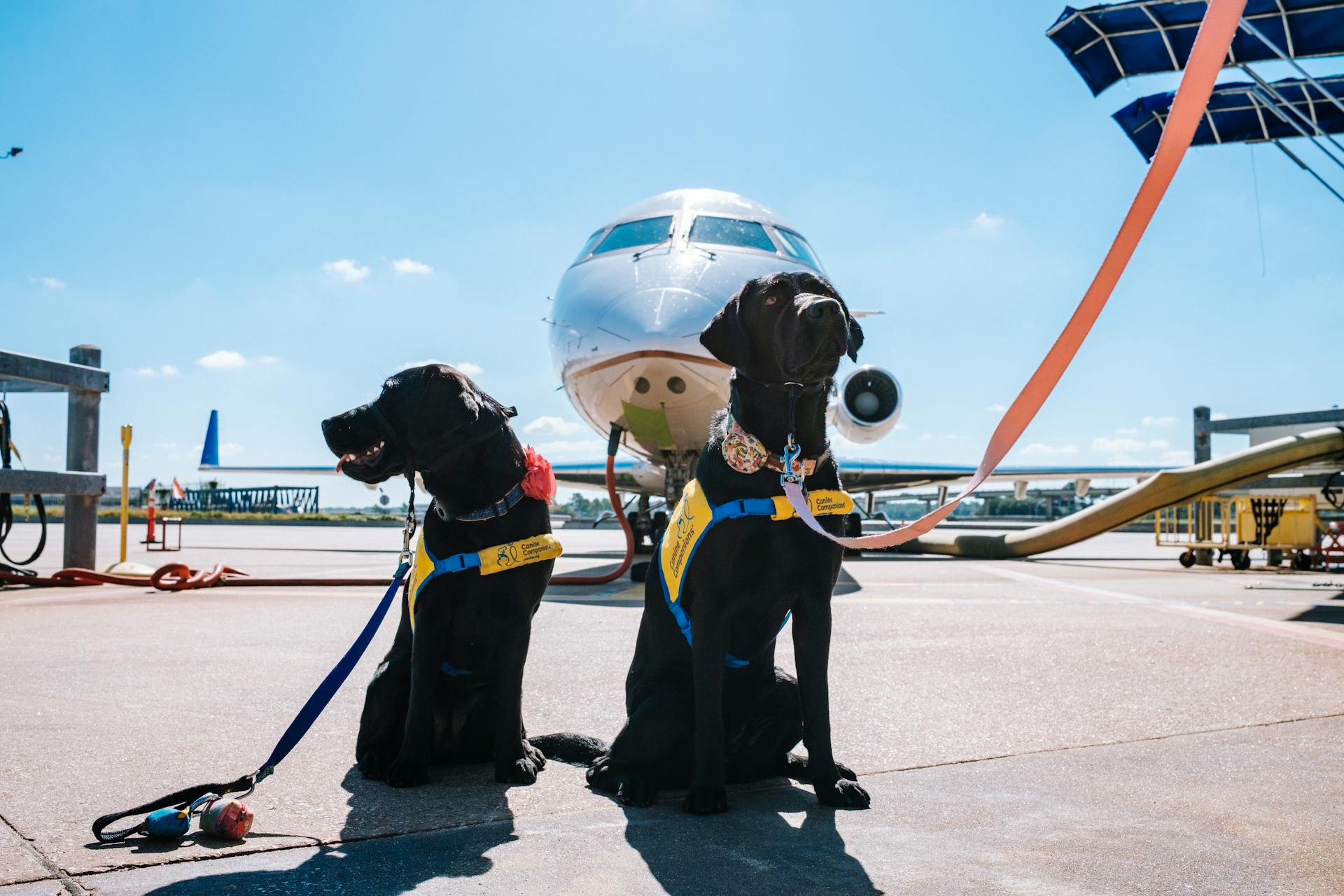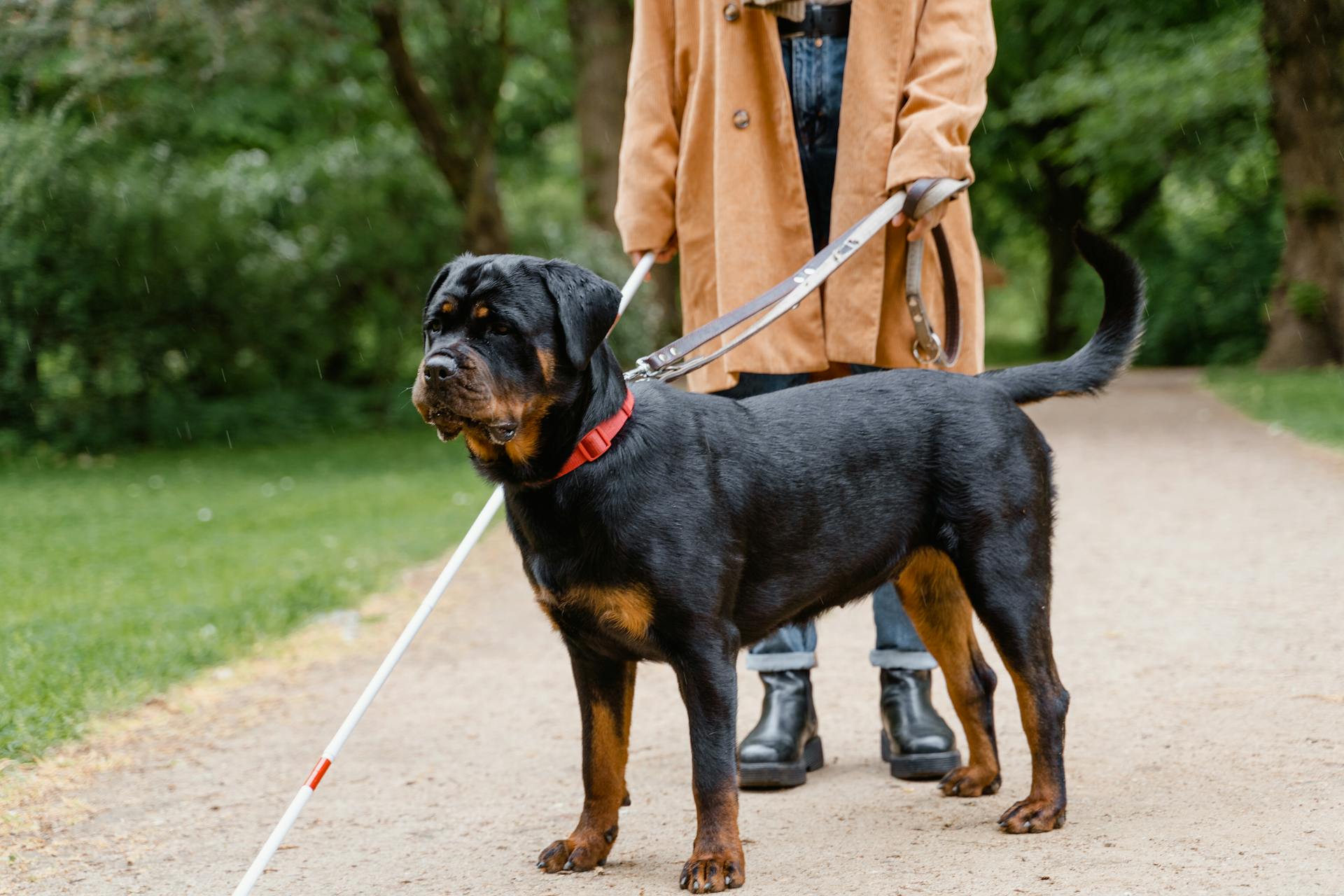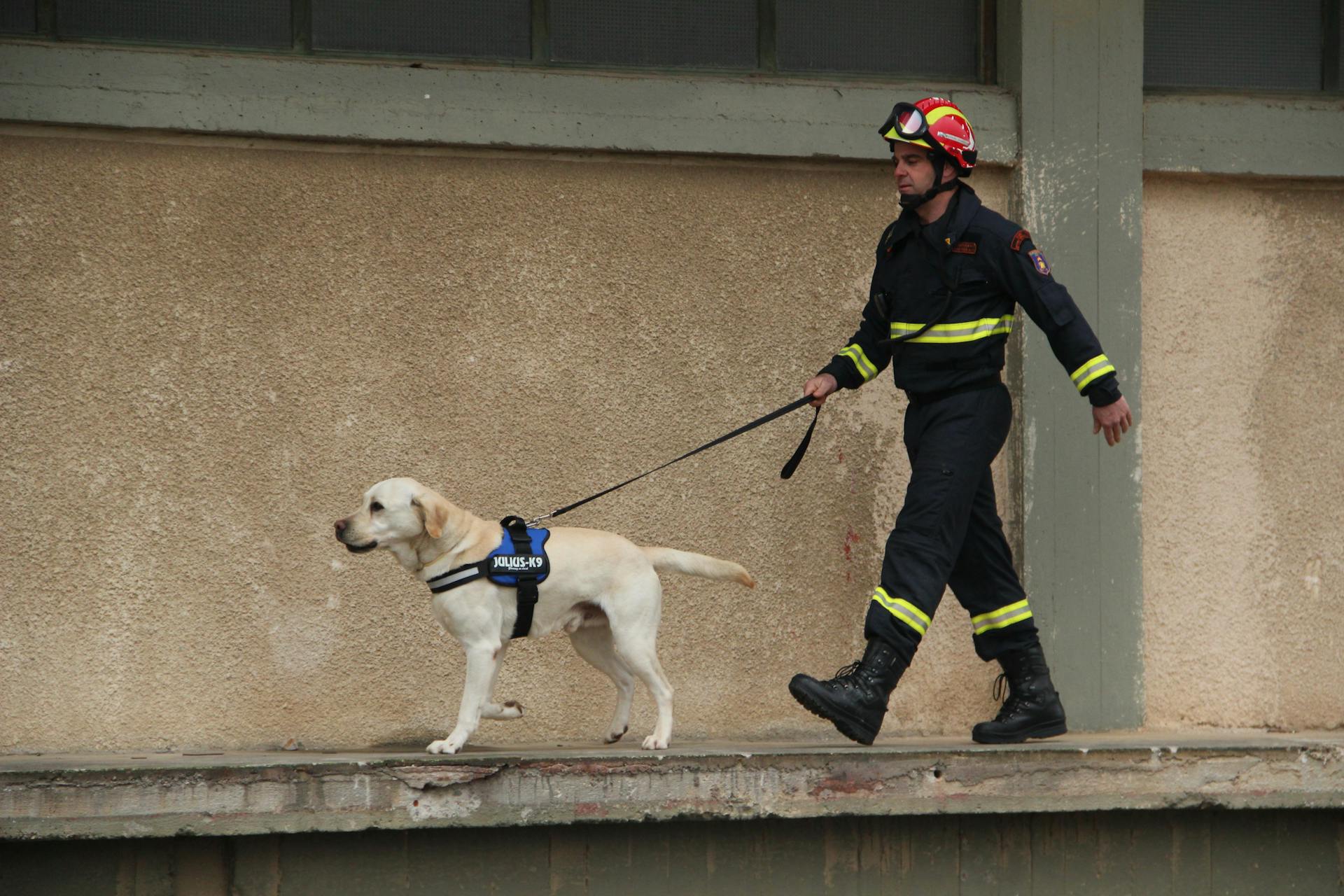
Service dogs are allowed to be off-leash in certain situations, such as when they're being trained or when they're in a designated off-leash area.
In the United States, the Americans with Disabilities Act (ADA) requires service dogs to be under the control of their handler, but it doesn't specify that they must be on a leash.
In public places, service dogs are often allowed to be off-leash, but only if they're being controlled by their handler and not posing a threat to others.
Service dogs are trained to be responsive to their handlers and can be trusted to behave in public, even without a leash.
Expand your knowledge: Is It Illegal for a Dog to Be off Lead
Service Dog Laws
Service dogs must be under control at all times in public, which means they should be leashed or otherwise tethered. This is a requirement under the Americans with Disabilities Act (ADA).
In most cases, the person who has control over the service animal is the service dog user, the individual who benefits from the performed tasks. However, in some cases, the user may need assistance from a third party to handle the dog, and in these situations, the handler and the user are different people.

Service dogs are allowed to be off-leash in cases where the leash or tethering device interferes with the ability of the dog to perform the learned tasks. This is stated in the ADA, which provides examples of situations where this might be necessary, such as for returning veterans with PTSD who need a service dog to help them enter unknown places.
The ADA also allows for the use of long extendable leashes for service dogs that need to retrieve items at a long distance, such as a phone or medication. This helps ensure that the dog is under control and won't wander around.
Service dogs are subject to local dog licensing and registration requirements, just like any other dog. They must be on a leash unless they are in an area where leashes are not required.
The ADA strictly states that service animals must be under control at all times, which means they should be leashed, tethered, or otherwise harnessed in public areas. The only exception to this is if the leash directly interferes with a dog's duties.
In cases where a person's disability makes leash use impossible, the ADA permits an exception. For example, a wheelchair user who is paralyzed from the neck down may require the assistance of an animal to help cross the street, enter buildings, and such, but obviously, the owner cannot physically hold the leash.
It's essential to carry documentation for your assistance animal, such as a service dog ID card, to prove its legitimacy. This can help prevent issues when entering public spaces with your animal.
Recommended read: Service Dogs Registration
Service Dog Training and Supervision

Service dogs need to be under control at all times when in public, which means they should be on a leash or otherwise tethered. This is a requirement for service animals.
However, there are exceptions to the rule. According to the Americans with Disabilities Act (ADA), service dogs can be off-leash if the leash or tethering device interferes with their ability to perform their tasks. This is often the case for returning veterans with PTSD who need their service dog to help them enter unknown places safely.
Leash training is a crucial part of service dog training, and it's essential for service animals to be able to calmly walk on a leash and maintain their focus on the handler. This training should start with basic obedience and extend to more complex tasks like focus training and "heel".
For your interest: Are Service Animals Only Dogs
Training
Training is a crucial aspect of service dog development. Service dogs need to be trained in basic obedience, including "sit", "stay", "name", and "come".
Leash training is a fundamental part of service dog training. It's essential for service animals to calmly walk on a leash and maintain their focus on the handler.
Proper leash training ensures that service dogs don't pull on a leash or try to jump on other dogs or people. This helps maintain a safe and respectful environment.
The type of leash used should be suitable for the dog's age, size, and obedience skills. It's also important to consider when and where to start leash training.
A well-trained service dog is confident in navigating various surroundings. This confidence comes from being able to calmly enter public settings and respond to their handler's commands.
Leash training, combined with focus training, teaches dogs to remain calm when walking by their owner's side.
Curious to learn more? Check out: How Do Service Dogs Know When to Alert
Service Dogs Require Constant Supervision
Service dogs must be under control at all times when in public, which means they have to be on a leash or otherwise tethered. This is a requirement for service animals under the Americans with Disabilities Act (ADA).

The ADA allows service dogs to be off-leash in certain situations, such as when the leash would interfere with their ability to perform their tasks. For example, returning veterans with PTSD may need a service dog to detect threats and return to their handler, and an off-leash service dog can be used in these situations.
Service dogs are allowed to be off-leash when it's necessary for them to do their job as medical equipment, but in all other situations, they must be on a leash. This ensures that the dog remains under control and doesn't wander off.
In fact, service dogs are required to be on leashes unless it interferes with their jobs, according to the ADA. This is a compromise that allows service dogs to be present in places where dogs are typically not allowed.
Not all service dogs have to be on a leash at all times, but for the most part, they will be on leashes. This helps them to behave properly and keeps their minds on their jobs.
A unique perspective: When Do Service Dogs Retire
Service Dog Leash Requirements

Service dogs must be under control at all times when in public, which means they have to be on a leash or otherwise tethered. This is a requirement by the Americans with Disabilities Act (ADA).
In most cases, the person who has control over the service animal is the service dog user, the individual who benefits from the performed tasks. However, in some cases, the user may need assistance from a third party to handle the dog.
The ADA states that service dogs are allowed to be off-leash if the leash or tethering device interferes with the ability of the dog to perform the learned tasks. This is the case for returning veterans with PTSD who need a service dog to help them enter unknown places.
A long extendable leash may be used if a disabled individual needs a service dog to retrieve items at a long distance. This ensures the dog is under control and won't wander around.
Additional reading: Are Psychiatric Service Dogs Covered under the Ada

Service dogs need to be on leashes unless it interferes with their jobs, which is a compromise to allow them in places where dogs can't go. This means they have to behave in a certain way to be allowed in public.
Not all service dogs have to be on a leash at all times, but for the most part, they will be on leashes. This helps them to behave properly and keeps their minds on their jobs.
There are cases where a person's disability makes leash use impossible, and in that case, the ADA permits an exception. One example is a wheelchair user who is paralyzed from the neck down and needs the assistance of an animal to help cross the street.
The ADA states that service dogs must obey the same leash laws as all other dogs. This requirement means they must be leashed or harnessed when outside the home – at all times.
You might enjoy: Types of Dog Leash
Frequently Asked Questions
Can someone ask me for papers on my service dog?
No, you cannot ask for papers or documentation on my service dog. Asking for proof or details about my service dog is not allowed under the law.
Sources
- https://www.servicedogtrainingschool.org/blog/do-service-dogs-have-to-be-on-a-leash
- https://sitstay.com/blogs/good-dog-blog/do-service-dogs-have-to-be-on-leash-at-all-times
- https://www.ada.gov/resources/service-animals-faqs/
- https://www.nsarco.com/what-you-should-know-about-leash-laws-and-service-dogs/
- https://www.servicedogregistration.org/blog/do-service-dogs-have-to-be-on-leash/
Featured Images: pexels.com


